
Load Code for the Design of Building Structures 建筑结构荷载规范 GB50009-2001 (英文版) Beijing 2002

NOTICE The code is written in Chinese and English.The Chinese text shall be taken as the ruling one in the event of any inconsistency between the Chinese text and the English text

Notice of Promulgation for the National Standard"Load Code for the Design of Building Structures" Document JB [2002]No.10 According to the requirements of"Notice of Printing and Distributing for the 1997 Preparation and Revision Plan of Engineering Construction Standards'(Document B[1997]No.108)-Ministry of Construction",that the"Load Code for the Design of Building Structures"has been revised by Ministry of Construction together with the relevant departments,after a joint xamination of relevant depart- ments,hence the new code has been approved as a national standard with a serial number of GB50009-2001,and it shall come into force upon March 1,2002.Herein,clauses 1.0.5,3.1.2, 3.2.3,3.2.5,4.1.1,4.1.2,4.3.1,4.5.1,4.5.2,6.1.1,6.1.2,7.1.1and7.1.2ae mandatory clauses,which must be enforced strictly.The original"Load Code for the Design of Building Structures"GBJ987 shall be abolished after December 31,2002 The Ministry of Construction is in charge of management and explanation of the mandatory clauses in the code,the China Academy of Building Research will be responsible for the explanation of specific technicaont and the Research Institute of Standards and Noms-Ministry of Construction will organize the China Architecture Building Press to take on publishing and distributing works of this code Ministry of Construction of the People's Republic of China January 10,2002
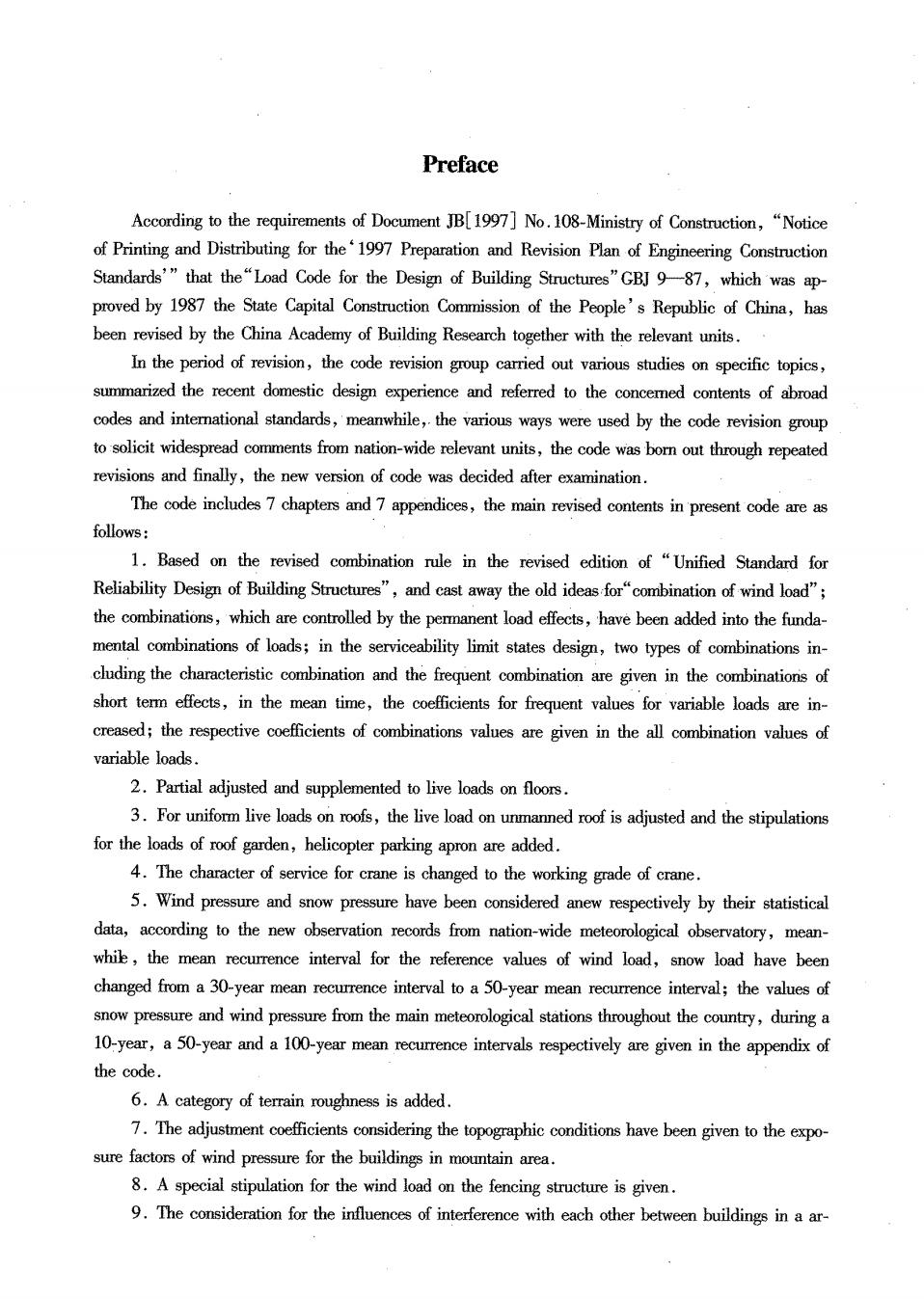
Preface According to the requirements of Document JB[1997]No.108-Ministry of Construction,"Notice of Printing and Distributing for the1997 Preparation and Revision Plan of Engineering Construction Standards'"that the"Load Code for the Design of Building Structures"GB]987,which was ap- proved by 1987 the State Capital Construction Commission of the Peoples Republic of China,has been revised by the China Academy of Building Research together with the relevant units. In the period of revision,the code revision group carried out various studies on specific topics, smmarized the recent domestic design experience and referred to the concemed contents of aboad codes and intemational standards,meanwhile,the various ways were used by the code revision group tosolicit widespread relevant units,the code was bom out through repeated revisions and finally,the new version of code was decided after examination. The cde includes7 chapters and 7 appendices,the main revised neinpresent codereas follows: 1.Based on the revised combination rule in the revised edition of "Unified Standard for Reliability Design of Building Structures"and cast away the od ideasfor"combination of wind od" the combinations,which are controlled by the permanent load effects,have been added into the funda- mental combinations of loads;in the serviceability limit states design,two types of combinations in- cluding the characteristic combination and the frequent combination are given in the combinations of short term effects,in the mean time,the coefficients for frequent values for variable loads are in- creased;the respective coefficients of combinations values are given in the all combination values of variable loads. 2.Partial adjusted and supplemented to live loads 3.For uniform live loads on roofs,the live load on unmanned roof is adjusted and the stipulations for the loads of roof garden,helicopter parking apron are added 4.The character of service for crane is changed to the working grade of crane 5.Wind pressure and snow pressure have been considered anew respectively by their statistical data,according to the new from ntion-wide observatory,mean- whil,the mean recurrence interval for the reference values of wind load,snow load have been changed from a30-year mean recurence interval to a50-year mean recurrence interal;the values of ow pressure and wind pressure from the main meteorological stations throughout the counry,during a 10-year,a50-year and a 100-year mean recurence intervals respectively are given in the appendix of the code. 6.A category of terrain roughness is added. 7.The adjustment the topographic conditions have been given to the expo sure factors of wind pressure for the buildings in mountain area. 8.A special stipulation for the wind oad on the fencing structure is given. 9.The consideration for the influences of interference with each other between buildings in a ar-
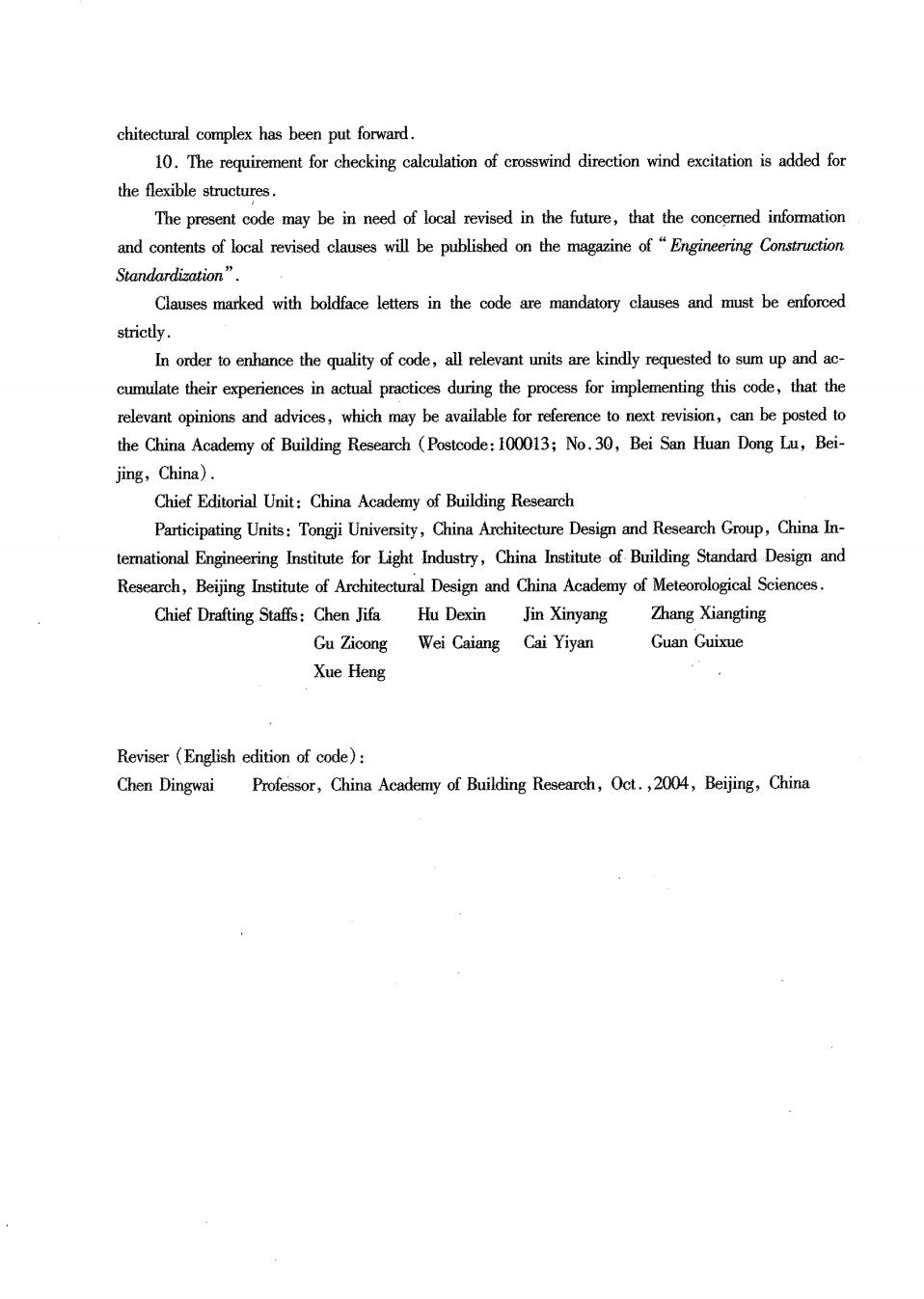
chitectural complex has been put forward. 10.The requirement for checking calculation of crosswind direction wind excitation is added for the flexible structures The present code may be in need of local revised in the future,that the concered information and contents of local revised clauses will be published on the magazine of"Engineering Construction Standardization" Clauses marked with boldface letters in the code are mandatory clauses and must be enforced strictly. In order to enhance the quality of code,all relevant units are kindly requested to sum up and ac cumulate their experiences in actual practices during the processfor implementing this coe,that the relevant opinions and advices,which may be available for reference to next revision,can be posted to the China Academy of Building Research(Postcode:100013;No.30,Bei San Huan Dong Lu,Bei- jing,China). Chief Editorial Unit:China Academy of Building Research Participating Units:Tongii University,China Architecture Design and Research Group,China In- temational Engineering Institute for Light Industry,China Institute of Building Standard Design and Research,Beijing Institute of Architectural Design and China Academy of Meteorological Sciences. Chief Drafting Staffs:Chen Jifa Hu Dexin Jin Xinyang Zhang Xiangting Gu Zicong Wei Caiang Cai Yiyan Guan Guixue Xue Heng Reviser (English edition of code): Chen Dingwai Profr,China Academy of Building ResearchOct4 Beijing,China

Table of Contents I General Principles..... 2 Terms and Symbols……2 2.1Tems…2 2.2 Symbol6…4 3 assification of L0 ads and Combination of l0 ad Effects*………………6 3.1 Classification of Loads and Representative Values of Loads …6 3.2 Combination of Loads.....................7 4 Live Loads on Eloors and Roofs..0 4.1 Uniform Live Loads on Floors in Civil Buildings 4.2 Live Loads on Floors in Industrial Buildings.............................12 4.3 Live Loads on Roofs...13 44AghL0阳d0nR00 4.................**t+…14 4.5 Construction and Maintenance Loads,and Horizontal Load on Railings …16 4.6 Dynamic Coefficient....16 5 Crane Load …17 5.1 Vertical and Horizontal Crane Loads...............17 5.2 Combination of Multi-crane........17 5.3 Dynamic Coefficients of Crane Loads …18 5.4 Combination Value,Frequent Value and Quasi-permanent Value of Crane Load ++*…18 6 Snow Load …19 6.1 Characteristic Value of Snow Load and Reference Snow Pressure.......19 6.2 Roofing Snow Cover Distribution Factor.19 7WmdL0ad…23 7.1 Characteristic Value of Wind Load and Reference Wind Pressure..................23 7.2 Exposure Factor for Wind Pressure ……23 7.3 Shape Factor of Wind Load.....................25 7.4 Along Wind Direction Wind Excitation and Dynamie Wind Effect 7.5 Gust Fact0r…42 7.6 Cross Wind Direction Wind Excitation...........................43 Appendix A Self-weight of Commonly Used Materials and Structural Members Appendix B Determination Method of Equivalent Uniform Live Loads on Floors.57 Appendix C Live Loads on Floors in Industrial Buildings60 Appendix D Determination Method for the Reference Snow Pressure and Wind Pressure.......65 D.1 Reference Snow Pressure..65 D.2 Reference Wind Pressure D.3 Statistical Calculation of Snow Pressure and Wind Velocity.66
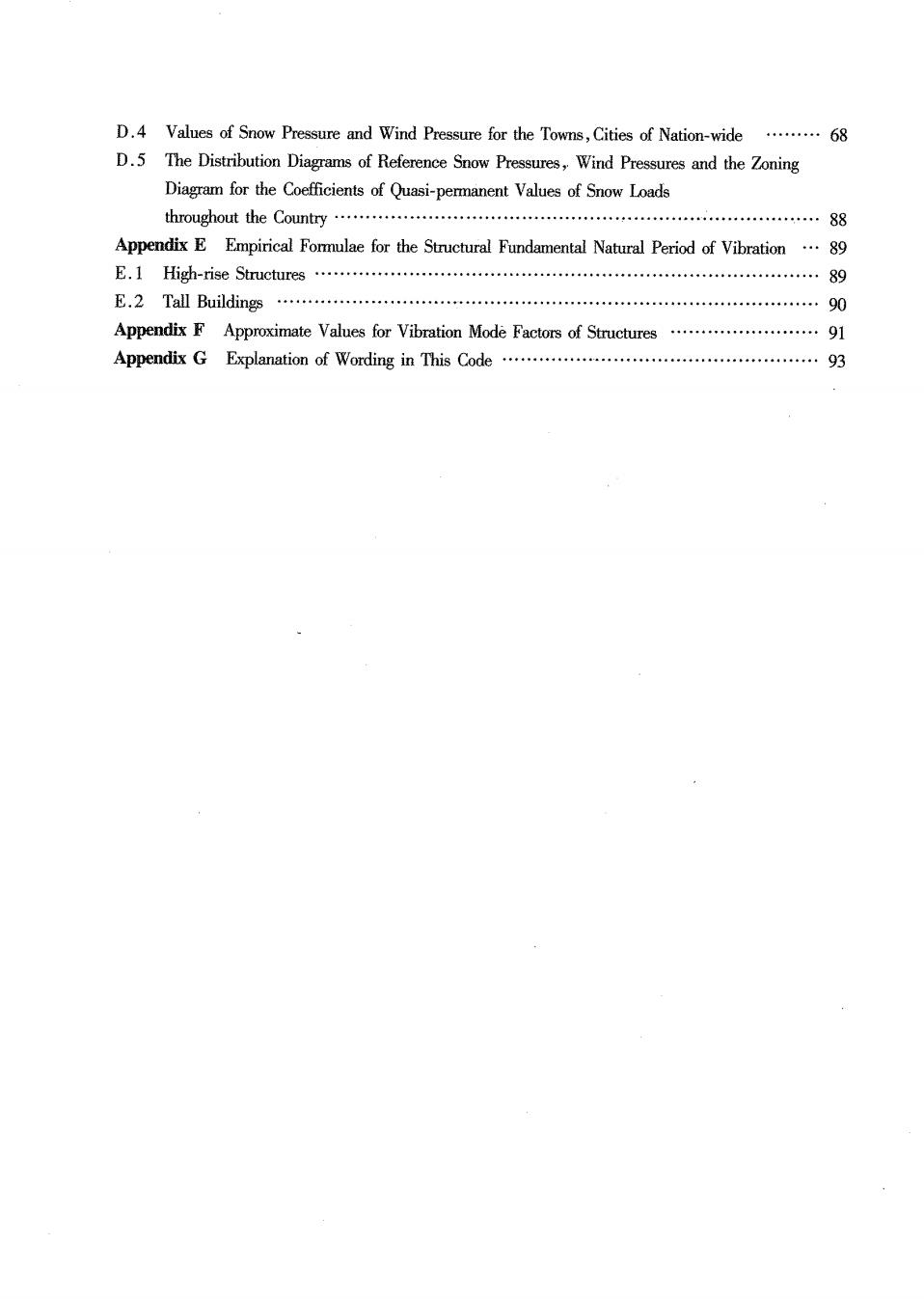
D.4 Values of Snow Pressure and Wind Pressure for the Towns,Cities of Nation-wide........68 D.5 The Distribution Diagrams of Reference Snow Pressures,Wind Pressures and the Zoning Diagram for the Coefficients of Quasi-permanent Values of Snow Loads throughout the Country.88 Appendix E Empirical Formulae for the Structural Fundamental Natural Period of Vibration.89 E.1 High-rise Structure.............................89 E.2 Tall Buildings 90 Appendix F Approximate Values for Vibration Mode Factors of Structures......91 Appendix G Explanation of Wording in This Code
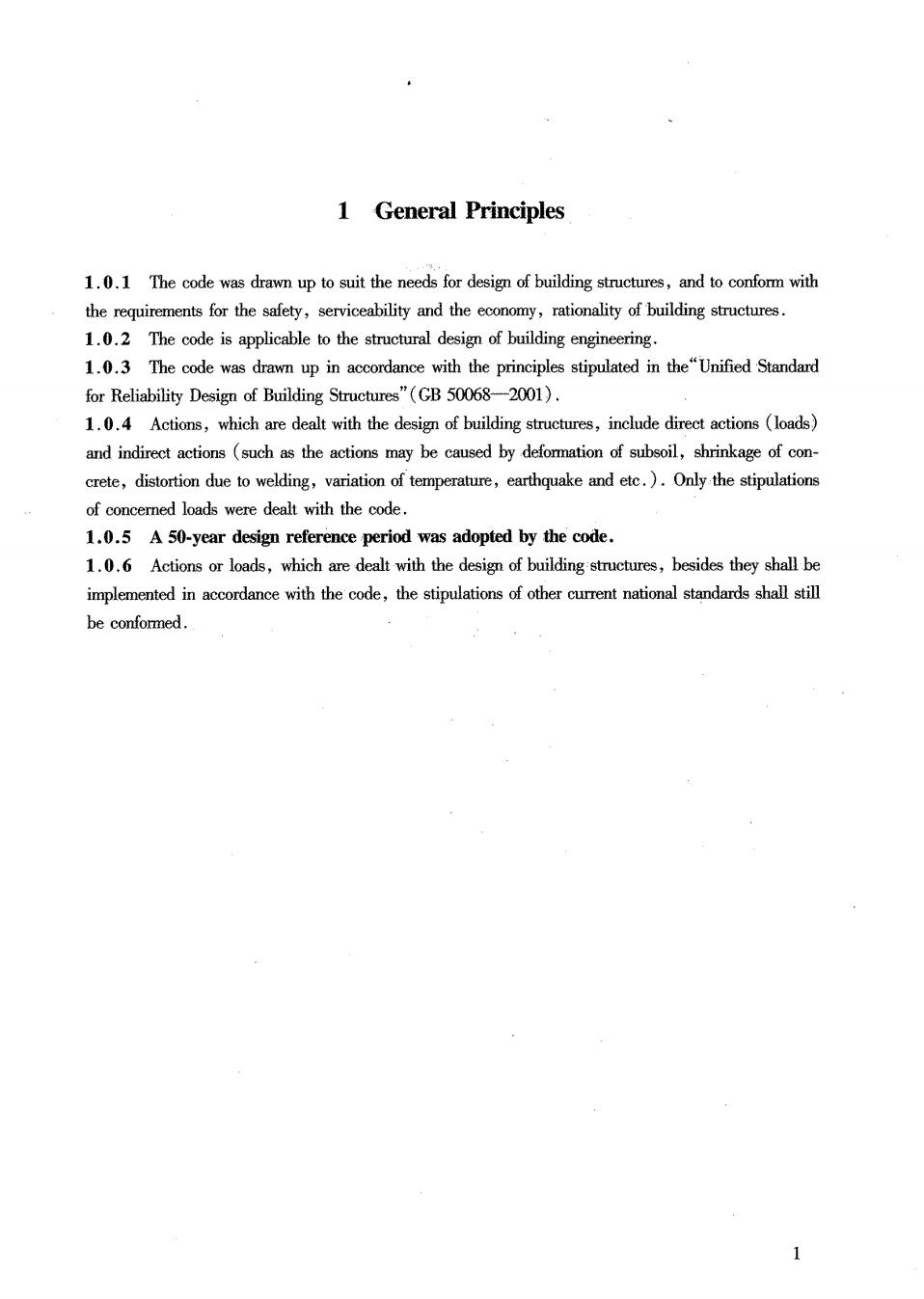
1 General Principles 1.0.1 The code was drawn up to suit the needs for design of building structures,and to confom with the requirements for the safety,serviceability and the economy,rationality of building structures. 1.0.2 The code is applicable to the structural design of building engineering. 1.0.3 The code was drawn up in accordance with the principles stipulated in the"Unified Standard for Reliability Design of Building Structures"(GB 50068-2001). 1.0.4 Actions,which are dealt with the design of building structures,include direct actions (loads) and indirect actions (such as the actions may be caused by deformation of subsoil,shrinkage of con- crete,distortion due to welding,variation of temperature,earthquake and ete.).Only the stipulations of concered loads were dealt with the code. 1.0.5 A 50-year design reference period was adopted by the code. 1.0.6 Actions or loads,which are dealt with the design of building structures,besides they shall be implemented in accordance with the code,the stipulations of other current national standards shall still be conformed
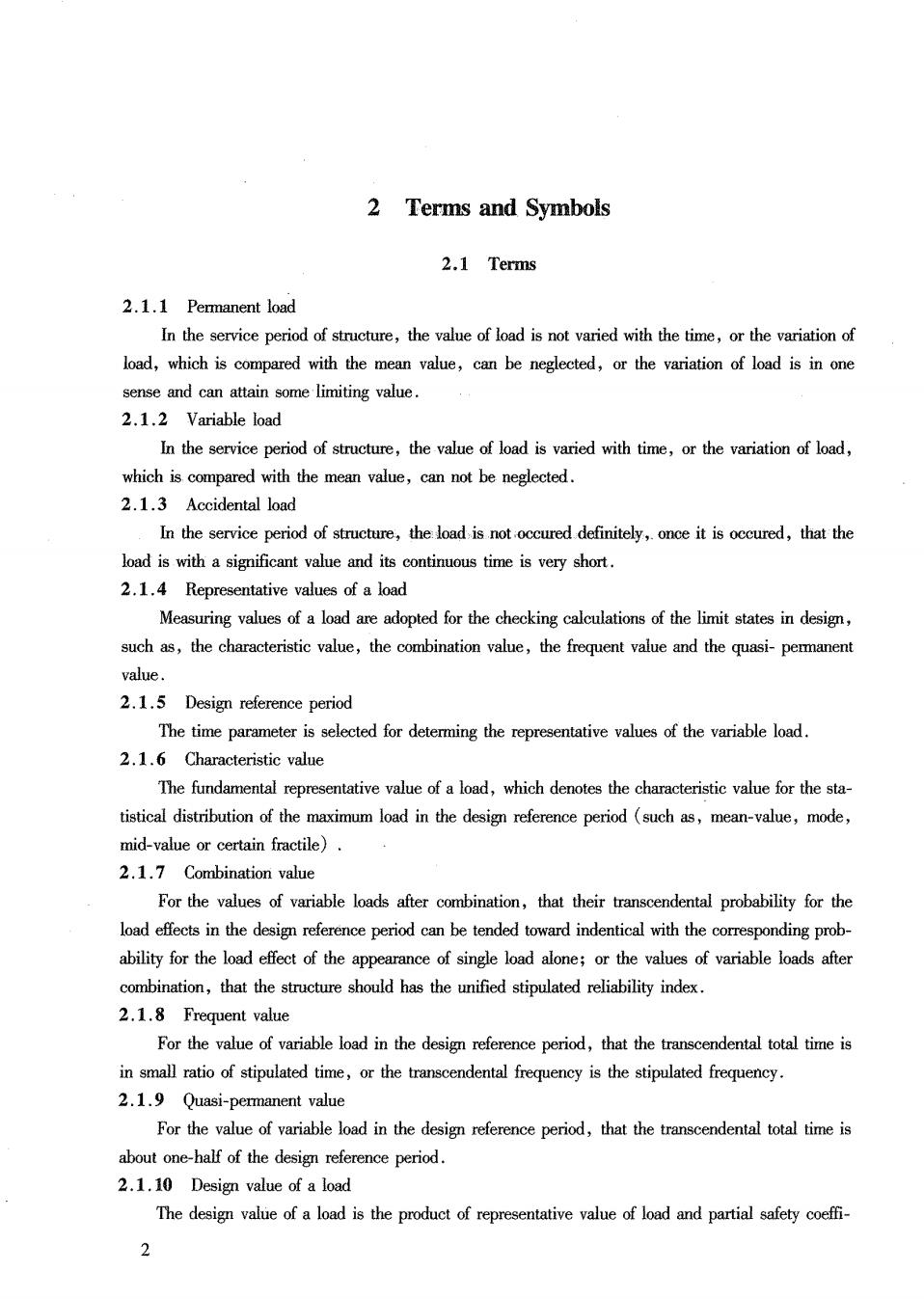
2 Terms and Symbols 2.1 Terms 2.1.1 Permanent load In the service period of stcture,the value of load is not varied with the time,or the variation of load,which is compared with the mean value,can be neglected,or the variation of load is in one sense and can attainsome limiting value 2.1.2 Variable load In the service period of structure,the value of load is varied with time,or the variation of load, which is compared with the mean value,can not be neglected. 2.1.3 Accidental load In the service period of structure,the load is notoccured definitely,once it is occured,that the load is with a significant value and its continuous time is very short. 2.1.4 Representative values of a load Measuring values of a load are adopted for the checking calculations of the limit states in design, such as,the characteristic value,the combination value,the frequent value and the quas-pemanent value. 2.1.5 Design reference period The time parameter is selected for determing the represenative values of the variable load. 2.1.6 Characteristic value The fundamental representative value of a load,which denotes the characteristic value for the sta tistical distribution of the maximum load in the design reference period (such as,mean-value,mode, mid-value or certain fractile) 2.1.7 Combination value For the values of variable loads after combination,that their transcendental probability for the load effects in the design reference period can be tended toward indentical with the eponding prob- ability for the load effect of the appearance of single load alone;or the values of variable loads after combination,that the should has the unified stipulated reliability index 2.1.8 Frequent value For the value of variable load in the design reference period,that the transcendental total time is in small ratio of stipulated time,or the transcendental frequency is the stipulated frequency. 2.1.9 Quasi-permanent value For the value of variable load in the design reference period,that the transcendental total time is about one-half of the design reference period. 2.1.10 Design value of a load The design value of a load is the product of representative value of load and partial safety coeffi-
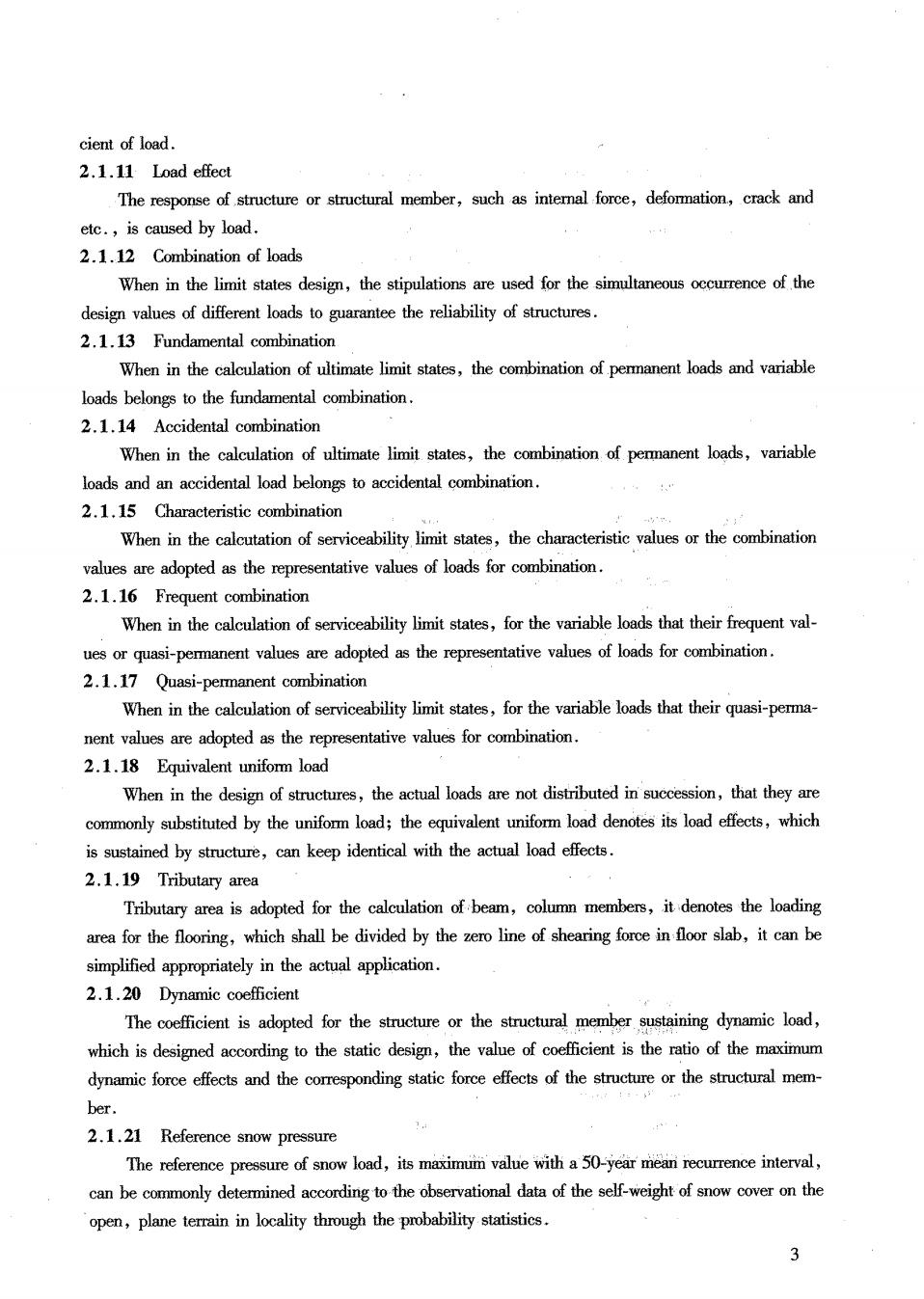
cient of load. 2.1.11 Load effect The response of structure or structural member,such as intemal force,defommation,crack and etc.,is caused by load. 2.1.12 Combination of loads When in the limit states design,the stipulations are used for the simultaneous occurrence of the design values of different loads to guarantee the reliability of structures. 2.1.13 Fundamental combination When in the calculation of utimate limit states,the combination of permanent loads and variable loads belongs to the fundamental combination. 2.1.14 Accidental combination When in the calculation of ultimate limit states,the combination of permanent loads,variable loads and an accidental load belongs to accidental combination 2.1.15 Characteristic combination When in the calcutation of serviceability limit states,the characteristic values or the combination valuesare adopted s the representative values of loadsfor combination 2.1.16 Frequent combination When in the calculation of serviceability limit states,for the variable loads that their frequent val- ues or quasi-permanent values are adopted as the representative values of loads for combination. 2.1.17 Quasi-permanent combination When in the calculation of serviceability limit states,for the variable loads that their quasi-pea nent values are adopted as the representative values for combination. 2.1.18 Equivalent unifor load When in the design of structures,the actual loads are not distributed in succession,that they are commonly substituted by the unifor lod;the equivalent unifo oad denotes its load effects,which is sustained by structure,can keep identical with the actual load effects 2.1.19 Tributary area Tributary area is adopted for the calculation of beam,column members,it denotes the loading area for the flooring,which shall be divided by the zero line of shearing force in floor slab,it can be 2.1.20 Dynamic coefficient The coefficient is adopted for the structure or the structural member sustaining dynamic load which is designed according to the static design,the vale of ffic is the ratio of the maximum dynamic force effects and the corresponding static force effects of the structurer the structural mem ber. 2.1.21 Reference snow pressure The reference pressure of sow load,its value with a50-year mean interal, can be commonly determined according to the observational data of the self-weight of snow cover on the open,plane terain in locality the probability satistics